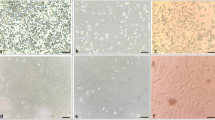Summary
In an experimental study we compared two methods of preparing transplants in rabbits (n = 66): 1. 4–5 splenic fragments with a thickness of 1 mm and graduated weight (5–800 mg) were attached onto the peritoneal peritoneum. 2. Splenic homogenates with increasing weight (5–800 mg) were placed in 4–5 preformed pockets in the parietal peritoneum. At different postoperative intervals (maximum 42 days), a relaparotomy was performed. The regenerated splenic tissue was dissected, weighed and histologically examined. We found a linear correlation between pre- and postoperative weight. However, this correlation applies only to the homogenates with a weight of maximal 200 mg and to the fragments with a weight of maximal 300 mg. We have come to the conclusion that homogenates regenerate better than fragments.
Zusammenfassung
In einer experimentellen Studie an 66 Kaninchen verglichen wir zwei Arten der Transplantatzubereitung: 1. 4–5 Milzstücke von 1 mm Dicke steigenden Gewichts (5–800 mg) wurden am parietalen Peritoneum angenäht. 2. Milzhomogenate wurden ebenfalls in steigender Menge (5–800 mg) in 4–5 präformierte Taschen des parietalen Peritoneums eingebracht. Das regenerierte Milzgewebe wurde nach Laparotomie der Tiere in verschiedenen postoperativen Abständen bis maximal 42 Tage postoperativ entnommen, gewogen und histologisch untersucht. Dabei zeigt sich eine lineare Beziehung von End- und Anfangsgewichten. Diese Korrelation gilt aber nur bis zu einer oberen Gewichtsgrenze von 200 mg bei den Homogenaten und 300 mg bei den Stücken. Insgesamt regenerierten Homogenate besser als Stücke.
Similar content being viewed by others
Literatur
Aigner K, Schwemmle K, Dobroschke J, Hild P, Henneking K, Bauer M, Teuber J, Schwetlick G (1981) Reimplantation von Milzgewebe nach geburtstraumatischer Milzruptur. Langenbecks Arch Chir 354:39
Aigner K, Dobroschke J, Hild P (1981) Reimplantation von Milzgewebe nach traumatischen Läsionen beim Kind. Dtsch Med Wochenschr 51:1781
Benjamin JT, Komp DM, Shaw A, Cambell W, McMillan (1978) Alternatives of total splenectomy; two case reports. J Pediatr Surg 13:137
Buntain WL, Lynn HB (1979) Splenorrhaphy: Changing concepts for the traumatized spleen. Surgery 86:748–760
Dürig M, Heberer M, Harder F, Grotwohl A, Fridrich R (1983) Die Replantation autologen Milzgewebes zur Erhaltung der Organfunktion. Langenbecks Arch Chir (Kongreßber) 361:751
Gottlob R, Donas P, Mattausch M (1973) Untersuchung über die Speicherfähigkeit von regenerierten Miltransplantaten bei splenektomierten Versuchstieren. Acta Chir Austriaca 1:5–7
Höllerl G (1981) Versorgung der verletzten Milz mittels Fibrinklebung, Infrarot-Koagulation und Laserkoagulation. Acta Chir Austriaca 2 (Suppl):37
Holschneider AM, Däumling S, Strasser B, Belohradsky BH (1982) Erfahrungen mit der heterotopen Autotransplantation von Milzgewebe im Kindesalter. Z Kinderchir 35:145–152
Livaditis A, Sandberg G (1980) Splenic autotransplantation: An experimental study. Z Kinderchir 29:148
Meiser G, Meissner K, Schwaiger E (1983) Die autologe Replantation von Milzpulpa als Prophylaxe splenopriver Komplikationen. Acta Chir Austriaca Supplement 51
Patel J, Williams JS, Shmigel B, Hinshow JR (1981) Preservation of splenic function by autotransplantation of traumatized spleen in man. Surgery 90:683–688
Pearson HA, Johnston P, Smith UA, Tonloukion RJ (1978) The born-again spleen. Return of splenic function after splenectomy for trauma. New Engl J Med 298:1389
Scheele J (1981) Erste klinische Erfahrungen mit der Fibrinklebung bei traumatischer und intraoperativer Milzverletzung. Chirurg 52:531–534
Schwanz AD, Dadash-Zadeh M, Goldstein R, Luck S, Conway JJ (1977) Antibody response to intravenous immunisation following splenic tissue autotransplantation in Sprague-Dawley rats. Blood 49:779
Seufert RM, Böttcher W, Munz D, Heusermann U (1981) Erste klinische Erfahrungen mit der heterotopen Autotransplantation der Milz. Chirurg 52:525–530
Seufert RM, Böttcher W, Munz D (1983) Die Autotransplantation der Milz beim Menschen: Überprüfung der Transplantation nach 1–2 Jahren. Langenbecks Arch Chir (Kongreßber) 361:751
Singer DB (1973) Postsplenectomy sepsis. Perspect Pediatr Pathol 1:285
Tavasolli M, Ratzan RJ, Crosby WH (1973) Studies on regeneration of heterotopic splenic autotransplants. Blood 41:701
Vega A, Harell C, Compos J, Heyman S, Ziegler M, Koop CE (1981) Splenic autotransplantation: Optimal functional factors. J Pediatr Surg 16:898
Youssef S, Stauffer UG (1982) Heterotopic autotransplantation of splenic tissue after traumatic rupture of the spleen. A solution after unavoidable splenectomy? Z Kinderchir 35:88–89
Author information
Authors and Affiliations
Additional information
Universitätsinstitut für allgemeine Biologie, Biochemie und Biophysik: Abteilung Biochemie
Rights and permissions
About this article
Cite this article
Pimpl, W., Wayand, W., Thalhammer, J. et al. Experimentelle Studie zur Frage der Transplantatkonditionierung und Transplantatgröße bei heterotoper autologer Milztransplantation. Langenbecks Arch Chiv 362, 5–16 (1984). https://doi.org/10.1007/BF01263315
Received:
Issue Date:
DOI: https://doi.org/10.1007/BF01263315




